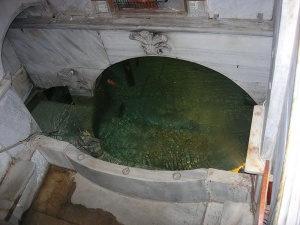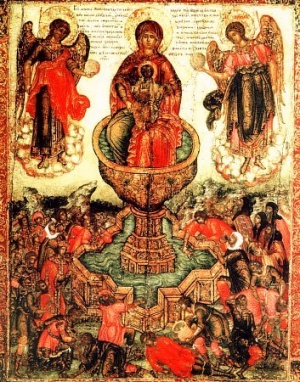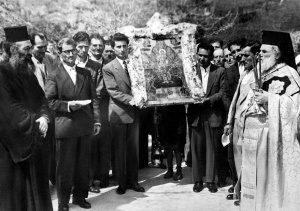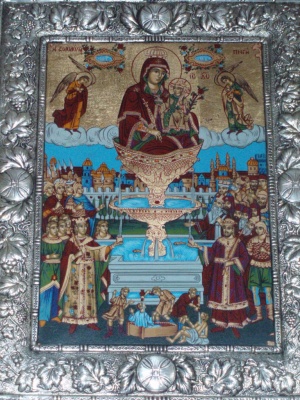Difference between revisions of "Life-Giving Spring"
(→List of Churches and Monasteries) |
m (link) |
||
| (28 intermediate revisions by 3 users not shown) | |||
| Line 1: | Line 1: | ||
| − | [[Image: | + | [[Image:Theotokos the Life-Giving Font.jpg|thumb|right|Icon of the Theotokos the Life-Giving Font. 17th c.]] |
| + | :''This article is about the [[feast day]] of the Life-Giving Spring. For the historic monastery see [[Church of the Life-Giving Font of the Theotokos (Istanbul)]].'' | ||
| + | The '''Life-Giving Spring''' or '''Life-Giving [[Font]]''' of the [[Theotokos|Mother of God]] (Greek: Ζωοδόχος Πηγή; Russian: Живоносный Источник) is a [[feast day]] in the Orthodox Church that is associated with [[Church of the Life-Giving Font of the Theotokos (Istanbul)|a historic church]] just west of Constantinople in [[w:Balıklı, Istanbul|Valoukli]], as well as an icon of the [[Theotokos]]. | ||
| − | The | + | The [[feast day]] of the Life-Giving Spring is commemorated on [[w:Easter Friday|Bright Friday]] of each year (the Friday following [[Pascha]]), being the only feast day which may be celebrated during [[Bright Week]], while the commemoration of the Life-Giving Spring ''[[Icon]]'' of the Most Holy [[Theotokos]] is observed on [[April 4]]. |
| − | |||
| − | |||
| − | |||
| − | |||
==Revelation of the Life-Giving Spring== | ==Revelation of the Life-Giving Spring== | ||
[[Image:Saint Mary Of The Spring.jpg|right|thumb|The [[w:Holy well|Holy well]] (Hagiasma) of the Church of the Life Giving Font (Istanbul).]] | [[Image:Saint Mary Of The Spring.jpg|right|thumb|The [[w:Holy well|Holy well]] (Hagiasma) of the Church of the Life Giving Font (Istanbul).]] | ||
| − | + | [[Image:Procession-Feast of Zoodohos Pigi-Arcadia,Greece-1950s.jpg|thumb|right|Procession on the [[feast day]] of the Life-giving Spring, [[w:Bright Friday|Bright Friday]] 1959, [[w:Arcadia|Arcadia]], Greece.]] | |
| − | + | There are two accounts extant concerning the revelation of the Life-Giving Font just outside the City of Constantinople. It is likely that in either case, before the 5th-6th century monastery was erected, a shrine was already in existence with a [[w:Spring (hydrosphere)|spring of water]], near a grove of trees, and was dedicated to the [[Theotokos]] from early times. Over time, the grove had become overgrown and the spring became fetid.<ref>Archpriest Feodor S. Kovalchuk. ''Wonder-Working Icons of the Theotokos.'' Youngstown OH: Central Satates Deanery, 1985. pp.67–70.</ref><br> | |
| − | |||
| − | |||
| − | |||
'''Nicephorus Callistus'''<br> | '''Nicephorus Callistus'''<br> | ||
| − | + | The traditional account is recorded by [[Nikephoros Kallistos|Nikephoros Kallistos Xanthopoulos]], the last of the Greek ecclesiastical historians, who flourished around 1320. This tradition begins with a miracle that occurred involving a soldier named Leo Marcellus, who would later become the Byzantine Emperor [[Leo I (emperor)|Leo I the Thracian]] (457-474). While Leo was on his way to Constantinople he encountered a blind man near the [[w:Walls_of_Constantinople#Golden_Gate_and_the_Yedikule_Fortress|Golden Gate]] who was thirsty. Though he agreed to search for water, he was unable to find any. A female voice was then heard who told the future Emperor that there was water nearby. Looking about, he could see no one, and neither could he see any water. Then he heard the voice again: | |
| − | :"Emperor Leo, go into the deepest part of the woods, and you will find water there. Take some of the cloudy water in your hands and give it to the blind man to drink. Then take the clay and put it on his eyes. Then you shall know who I am."<ref name="OCA">OCA - Feasts and Saints. [http://ocafs.oca.org/FeastSaintsLife.asp?FSID=32 Bright Friday. The Life Giving Spring of the Mother of God].</ref> | + | :"Emperor Leo, go into the deepest part of the woods, and you will find water there. Take some of the cloudy water in your hands and give it to the blind man to drink. Then take the clay and put it on his eyes. Then you shall know who I am."<ref name="OCA">OCA - Feasts and Saints. ''[http://ocafs.oca.org/FeastSaintsLife.asp?FSID=32 Bright Friday. The Life Giving Spring of the Mother of God].''</ref> |
| − | The same voice added that she had chosen that very place to be worshiped and prophesied that he would one day receive the crown to the empire. Leo followed her order and at once the blind man recovered his eyesight. After his accession to the throne, the Emperor erected a magnificent church on this place, and the water continued to work miraculous cures. Therefore, it was called "The Life-Giving Spring." | + | The same voice added that she had chosen that very place to be worshiped and prophesied that he would one day receive the crown to the empire. Leo followed her order and at once the blind man recovered his eyesight. After his accession to the throne, the Emperor erected a magnificent church on this place, and the water continued to work miraculous cures. Therefore, it was called "The Life-Giving Spring." |
| − | + | '''Procopius'''<br> | |
| − | |||
| − | |||
| − | ''' | ||
| − | |||
| − | |||
| − | |||
| − | |||
| − | |||
| − | |||
| − | |||
| − | |||
| − | |||
| − | |||
| − | |||
| − | |||
| − | |||
| − | |||
| − | + | A second account is given by the prominent Byzantine scholar [[w:Procopius|Procopius of Caesarea]] (flourishing ca.500-565).<ref group="note">The 11th century Byzantine historian [[w:George Kedrenos|George Cedrenus]] also mentions this version.</ref> In this version, the Emperor [[Justinian]] was out hunting when he came upon a small [[chapel]] in a beautiful wooded area, surrounded by a large crowd of people and a priest in front of a spring. Inquiring about this site, he was told that this was the “source of miracles”. He at once ordered that a magnificent church be built there, utilizing materials that had remained after the erection of the [[Hagia Sophia (Constantinople)|Hagia Sophia]].<ref name="JANIN">Raymond Janin (in French). ''La Géographie ecclésiastique de l'Empire byzantin. 1. Part: Le Siège de Constantinople et le Patriarcat Oecuménique. 3rd Vol.: Les Églises et les Monastères.'' Paris: Institut Français d'Etudes Byzantines. 1953. p.232-37.</ref> The church was erected in the last years of his reign, ca.559-560, near the holy spring.<ref group="note">In this context, "Holy Spring/Holy Font/Holy Source" becomes synonymous with the Greek: ἁγίασμα, ''hagiasma''; Lit.: 'sanctuary'.</ref> After the erection of the sanctuary, the Gate that was situated outside the [[w:Walls_of_Constantinople#Theodosian_Walls|walls of Theodosius II]] was named by the Byzantines ''Gate of the Spring'' (Greek: Πύλη τῆς Πηγῆς).<ref>Wolfgang Müller-Wiener (in German). ''Bildlexikon zur Topographie Istanbuls: Byzantion, Konstantinupolis, Istanbul bis zum Beginn d. 17 Jh..'' Tübingen: Wasmuth, 1977. pp.416.</ref> | |
| − | |||
==The Icon== | ==The Icon== | ||
| − | [[Image:Panagia Argokiliotissa.JPG|thumb| | + | [[Image:Panagia Argokiliotissa.JPG|thumb|right|Greek icon of the Theotokos the Life-giving Spring ("Panagia Argokiliotissa", Naxos).]] |
The icon representing the Virgin of the Spring shows the Virgin blessing and embracing the Child. She is surrounded by two angels, and is sitting on the more elevated of two basins, presumably representing the "living water" which is [[Christ]].<ref group="note">This living water is contained in the [[Cross]] which must be born by all those who follow Him, just as He did.</ref> The living water from the more elevated basin flows into a larger marble basin below, which is in the shape of a [[cross]].<ref group="note">In the early Church, the baptismal font was actually in the form of a cross, just like the cross depicted in this icon. Christians would enter from the base of the cross and come out at the top, and then re-enter from the left of the cross and come out on the right of the cross; then the priest, who would be standing in the middle of the cross/baptismal font, would commune them.</ref> | The icon representing the Virgin of the Spring shows the Virgin blessing and embracing the Child. She is surrounded by two angels, and is sitting on the more elevated of two basins, presumably representing the "living water" which is [[Christ]].<ref group="note">This living water is contained in the [[Cross]] which must be born by all those who follow Him, just as He did.</ref> The living water from the more elevated basin flows into a larger marble basin below, which is in the shape of a [[cross]].<ref group="note">In the early Church, the baptismal font was actually in the form of a cross, just like the cross depicted in this icon. Christians would enter from the base of the cross and come out at the top, and then re-enter from the left of the cross and come out on the right of the cross; then the priest, who would be standing in the middle of the cross/baptismal font, would commune them.</ref> | ||
| − | In one | + | In one version of the icon that was found on Naxos island, Greece,<ref group="note">Icon of "Panagia Argokiliotissa", from Naxos island, Greece (Greek: Παναγία η Αργοκοιλιώτισσα - Νάξος).</ref> some differences are shown with respect to the ancient type. Around the cross-shaped basin stands the Emperor with his guard, while on the right is the Patriarch with his bishops. In the background, is represented Leo I with the blind man, and the walls of the City. Under the basin a paralytic and a madman are healed with the spring’s water. |
<!--- | <!--- | ||
The fish in this pool, it is said, are descended from the fishes that miraculously jumped out of the frying-pan and into this spring ... (NOTE - research to find this story in more detail). | The fish in this pool, it is said, are descended from the fishes that miraculously jumped out of the frying-pan and into this spring ... (NOTE - research to find this story in more detail). | ||
---> | ---> | ||
| − | == | + | ==Hymn== |
| − | The | + | In Orthodox hymnography, the ''Theotokos'' is frequently compared with a ''Holy Fountain''. The hymns and prayers of the feast are combined with the Paschal hymns, and there is often a Lesser [[Holy water|Blessing of Waters]] performed after the [[Divine Liturgy]] on [[w:Easter Friday|Bright Friday]]. In old [[Church of Russia|Russia]], continuing Greek traditions, there was a custom to sanctify springs that were located near churches, dedicate them to the [[Theotokos|Holy Mother]], and paint icons of her under [[Theotokonymia|the title]] ''The Life Giving Spring''.<ref>Kristina Kondratieva (Global Art Communications project). ''[http://www.iconkuznetsov.com/index.php?sid=341&did=264&lang=eng Panagia The Life Giving Spring].'' Yuriy Kuznetsov: Icons of the XXI Century. Accessed: 2011-05-19.</ref> |
| + | |||
| − | '' | + | [[Troparion|Apolytikion]] (Tone 3)<ref name="OMHKSEA">[[Orthodox Metropolitanate of Hong Kong and Southeast Asia]]. ''[http://www.omhksea.org/2011/05/bright-friday/ Bright Friday].'' Accessed: 2011-09-28.</ref> |
| − | |||
| − | |||
| − | + | :As a life-giving fount, thou didst conceive the Dew that is transcendent in essence, | |
| − | + | :O Virgin Maid, and thou hast welled forth for our sakes the nectar of joy eternal, | |
| − | + | :which doth pour forth from thy fount with the water that springeth up | |
| − | + | :unto everlasting life in unending and mighty streams; | |
| + | :wherein, taking delight, we all cry out: | ||
| + | :Rejoice, O thou Spring of life for all men. | ||
| − | |||
| − | |||
| − | [[Kontakion]] ( | + | [[Kontakion]] (Plagal of Tone 4)<ref name="OMHKSEA"/> |
| − | :O | + | :O Lady graced by God, |
| − | : | + | :you reward me by letting gush forth, beyond reason, |
| − | : | + | :the ever-flowing waters of your grace from your perpetual Spring. |
| − | : | + | :I entreat you, who bore the Logos, in a manner beyond comprehension, |
| − | : | + | :to refresh me in your grace that I may cry out, |
| + | :“Hail redemptive waters.” | ||
==See also== | ==See also== | ||
| + | *[[Church of the Life-Giving Font of the Theotokos (Istanbul)]] | ||
| + | *[[Holy water]] | ||
*[[Panagia Blachernitissa]] | *[[Panagia Blachernitissa]] | ||
| − | |||
==Notes== | ==Notes== | ||
| Line 90: | Line 68: | ||
*[[w:Holy well|Holy well]] | *[[w:Holy well|Holy well]] | ||
'''Other''' | '''Other''' | ||
| + | *[http://iconreader.wordpress.com/2011/04/28/theotokos-of-the-life-giving-spring/ Gallery of Life-Giving Spring Icons] | ||
*[http://www.mgr.org/TheVeil.html The Miracle of The Veil] in Constantinople 911 AD. | *[http://www.mgr.org/TheVeil.html The Miracle of The Veil] in Constantinople 911 AD. | ||
*[http://www.orthodox.net/questions/bright_week_1.html#a5 Question 5. "What feast is celebrated Bright Friday?"], St Nicholas Russian Orthodox Church, Dallas Texas. | *[http://www.orthodox.net/questions/bright_week_1.html#a5 Question 5. "What feast is celebrated Bright Friday?"], St Nicholas Russian Orthodox Church, Dallas Texas. | ||
'''Greek Wikipedia''' | '''Greek Wikipedia''' | ||
*[http://el.wikipedia.org/wiki/%CE%96%CF%89%CE%BF%CE%B4%CF%8C%CF%87%CE%BF%CF%82_%CE%A0%CE%B7%CE%B3%CE%AE_%CF%84%CE%BF%CF%85_%CE%9C%CF%80%CE%B1%CE%BB%CE%BF%CF%85%CE%BA%CE%BB%CE%AE Ζωοδόχος Πηγή του Μπαλουκλή] | *[http://el.wikipedia.org/wiki/%CE%96%CF%89%CE%BF%CE%B4%CF%8C%CF%87%CE%BF%CF%82_%CE%A0%CE%B7%CE%B3%CE%AE_%CF%84%CE%BF%CF%85_%CE%9C%CF%80%CE%B1%CE%BB%CE%BF%CF%85%CE%BA%CE%BB%CE%AE Ζωοδόχος Πηγή του Μπαλουκλή] | ||
| + | '''Russian Orthodox Encyclopedia''' | ||
| + | *[http://www.pravenc.ru/text/182259.html «ЖИВОНОСНЫЙ ИСТОЧНИК»]. Православная Энциклопедия. | ||
| + | [[Category:Feasts]] | ||
[[Category:About Icons]] | [[Category:About Icons]] | ||
[[Category:Icons of the Theotokos]] | [[Category:Icons of the Theotokos]] | ||
[[Category:Theotokonymia]] | [[Category:Theotokonymia]] | ||
| − | [[ | + | |
| + | [[ro:Izvorul Tămăduirii]] | ||
Latest revision as of 02:18, December 1, 2012
- This article is about the feast day of the Life-Giving Spring. For the historic monastery see Church of the Life-Giving Font of the Theotokos (Istanbul).
The Life-Giving Spring or Life-Giving Font of the Mother of God (Greek: Ζωοδόχος Πηγή; Russian: Живоносный Источник) is a feast day in the Orthodox Church that is associated with a historic church just west of Constantinople in Valoukli, as well as an icon of the Theotokos.
The feast day of the Life-Giving Spring is commemorated on Bright Friday of each year (the Friday following Pascha), being the only feast day which may be celebrated during Bright Week, while the commemoration of the Life-Giving Spring Icon of the Most Holy Theotokos is observed on April 4.
Contents
Revelation of the Life-Giving Spring

There are two accounts extant concerning the revelation of the Life-Giving Font just outside the City of Constantinople. It is likely that in either case, before the 5th-6th century monastery was erected, a shrine was already in existence with a spring of water, near a grove of trees, and was dedicated to the Theotokos from early times. Over time, the grove had become overgrown and the spring became fetid.[1]
Nicephorus Callistus
The traditional account is recorded by Nikephoros Kallistos Xanthopoulos, the last of the Greek ecclesiastical historians, who flourished around 1320. This tradition begins with a miracle that occurred involving a soldier named Leo Marcellus, who would later become the Byzantine Emperor Leo I the Thracian (457-474). While Leo was on his way to Constantinople he encountered a blind man near the Golden Gate who was thirsty. Though he agreed to search for water, he was unable to find any. A female voice was then heard who told the future Emperor that there was water nearby. Looking about, he could see no one, and neither could he see any water. Then he heard the voice again:
- "Emperor Leo, go into the deepest part of the woods, and you will find water there. Take some of the cloudy water in your hands and give it to the blind man to drink. Then take the clay and put it on his eyes. Then you shall know who I am."[2]
The same voice added that she had chosen that very place to be worshiped and prophesied that he would one day receive the crown to the empire. Leo followed her order and at once the blind man recovered his eyesight. After his accession to the throne, the Emperor erected a magnificent church on this place, and the water continued to work miraculous cures. Therefore, it was called "The Life-Giving Spring."
Procopius
A second account is given by the prominent Byzantine scholar Procopius of Caesarea (flourishing ca.500-565).[note 1] In this version, the Emperor Justinian was out hunting when he came upon a small chapel in a beautiful wooded area, surrounded by a large crowd of people and a priest in front of a spring. Inquiring about this site, he was told that this was the “source of miracles”. He at once ordered that a magnificent church be built there, utilizing materials that had remained after the erection of the Hagia Sophia.[3] The church was erected in the last years of his reign, ca.559-560, near the holy spring.[note 2] After the erection of the sanctuary, the Gate that was situated outside the walls of Theodosius II was named by the Byzantines Gate of the Spring (Greek: Πύλη τῆς Πηγῆς).[4]
The Icon
The icon representing the Virgin of the Spring shows the Virgin blessing and embracing the Child. She is surrounded by two angels, and is sitting on the more elevated of two basins, presumably representing the "living water" which is Christ.[note 3] The living water from the more elevated basin flows into a larger marble basin below, which is in the shape of a cross.[note 4]
In one version of the icon that was found on Naxos island, Greece,[note 5] some differences are shown with respect to the ancient type. Around the cross-shaped basin stands the Emperor with his guard, while on the right is the Patriarch with his bishops. In the background, is represented Leo I with the blind man, and the walls of the City. Under the basin a paralytic and a madman are healed with the spring’s water.
Hymn
In Orthodox hymnography, the Theotokos is frequently compared with a Holy Fountain. The hymns and prayers of the feast are combined with the Paschal hymns, and there is often a Lesser Blessing of Waters performed after the Divine Liturgy on Bright Friday. In old Russia, continuing Greek traditions, there was a custom to sanctify springs that were located near churches, dedicate them to the Holy Mother, and paint icons of her under the title The Life Giving Spring.[5]
Apolytikion (Tone 3)[6]
- As a life-giving fount, thou didst conceive the Dew that is transcendent in essence,
- O Virgin Maid, and thou hast welled forth for our sakes the nectar of joy eternal,
- which doth pour forth from thy fount with the water that springeth up
- unto everlasting life in unending and mighty streams;
- wherein, taking delight, we all cry out:
- Rejoice, O thou Spring of life for all men.
Kontakion (Plagal of Tone 4)[6]
- O Lady graced by God,
- you reward me by letting gush forth, beyond reason,
- the ever-flowing waters of your grace from your perpetual Spring.
- I entreat you, who bore the Logos, in a manner beyond comprehension,
- to refresh me in your grace that I may cry out,
- “Hail redemptive waters.”
See also
Notes
- ↑ The 11th century Byzantine historian George Cedrenus also mentions this version.
- ↑ In this context, "Holy Spring/Holy Font/Holy Source" becomes synonymous with the Greek: ἁγίασμα, hagiasma; Lit.: 'sanctuary'.
- ↑ This living water is contained in the Cross which must be born by all those who follow Him, just as He did.
- ↑ In the early Church, the baptismal font was actually in the form of a cross, just like the cross depicted in this icon. Christians would enter from the base of the cross and come out at the top, and then re-enter from the left of the cross and come out on the right of the cross; then the priest, who would be standing in the middle of the cross/baptismal font, would commune them.
- ↑ Icon of "Panagia Argokiliotissa", from Naxos island, Greece (Greek: Παναγία η Αργοκοιλιώτισσα - Νάξος).
References
- ↑ Archpriest Feodor S. Kovalchuk. Wonder-Working Icons of the Theotokos. Youngstown OH: Central Satates Deanery, 1985. pp.67–70.
- ↑ OCA - Feasts and Saints. Bright Friday. The Life Giving Spring of the Mother of God.
- ↑ Raymond Janin (in French). La Géographie ecclésiastique de l'Empire byzantin. 1. Part: Le Siège de Constantinople et le Patriarcat Oecuménique. 3rd Vol.: Les Églises et les Monastères. Paris: Institut Français d'Etudes Byzantines. 1953. p.232-37.
- ↑ Wolfgang Müller-Wiener (in German). Bildlexikon zur Topographie Istanbuls: Byzantion, Konstantinupolis, Istanbul bis zum Beginn d. 17 Jh.. Tübingen: Wasmuth, 1977. pp.416.
- ↑ Kristina Kondratieva (Global Art Communications project). Panagia The Life Giving Spring. Yuriy Kuznetsov: Icons of the XXI Century. Accessed: 2011-05-19.
- ↑ 6.0 6.1 Orthodox Metropolitanate of Hong Kong and Southeast Asia. Bright Friday. Accessed: 2011-09-28.
External links
Wikipedia
Other
- Gallery of Life-Giving Spring Icons
- The Miracle of The Veil in Constantinople 911 AD.
- Question 5. "What feast is celebrated Bright Friday?", St Nicholas Russian Orthodox Church, Dallas Texas.
Greek Wikipedia
Russian Orthodox Encyclopedia
- «ЖИВОНОСНЫЙ ИСТОЧНИК». Православная Энциклопедия.
Categories > Arts
Categories > Arts
Categories > Church Life > Theotokonymia
Categories > Church Life > Theotokonymia > Icons of the Theotokos
Categories > Images > Icons
Categories > Liturgics > About Icons
Categories > Liturgics > About Icons
Categories > Liturgics > Feasts
Categories > Liturgics > Feasts
Categories > Liturgics > Feasts


